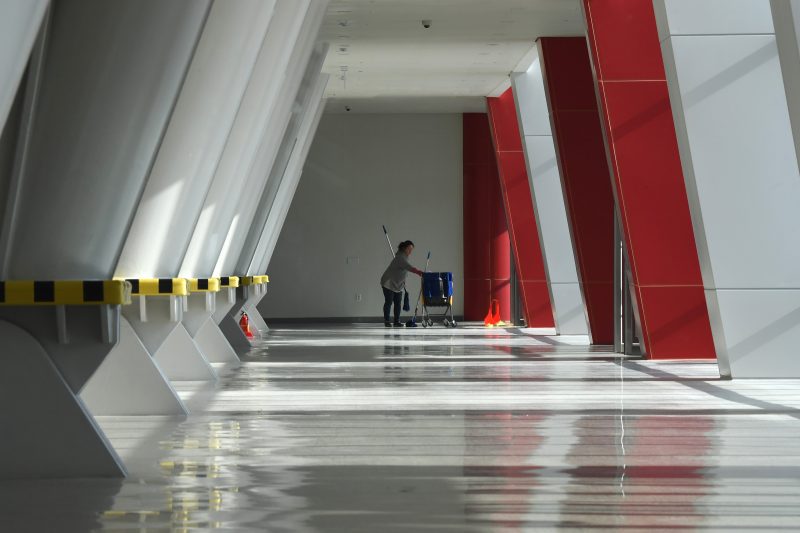Silence echoes across Pyeongchang Olympic venues
Hopes of a tourism boom have gone unfulfilled after the Winter Olympics (Jung Yeon-je)
Pyeongchang (South Korea) (AFP) – Just one year after the world’s best skiers and skaters gathered in South Korea to compete for Olympic gold, many of the venues stand empty, with arguments mounting over their future and upkeep costs.
The country built six sports centres and a ceremonial stadium from scratch for the 2018 Winter Olympics and renovated six existing facilities at a total cost of $800 million.
But today only the occasional elderly stroller passes through the Olympic park in Gangneung, where the cavernous speed-skating arena stands dark and ice-less.
The sliding centre in Pyeongchang, where South Korea’s Yun Sung-bin won Asia’s first Olympic skeleton gold, is locked with barriers blocking road access.
And protesters are demanding that a downhill ski slope site be developed into a resort and not, as promised, returned to nature.
South Korea also spent more than $10 billion on infrastructure before the Games, including a high-speed railway from Seoul to Gangneung, 200 kilometres (120 miles) east of the capital.
The construction bonanza was supposed to boost one of the poorest and least populated regions of Asia’s fourth-largest economy.
But hopes of a tourism boom have gone unfulfilled in a nation where bobsleigh and luge were largely unheard-of before the Olympics and participation in winter sports remains limited.
The risk of white elephants is a perennial issue for the Winter Games and the International Olympic Committee has struggled to find contenders willing to take on the burden.
There were only two candidates in the final round for the 2022 Games that ultimately went to Beijing, and after a series of withdrawals only two are bidding for 2026, Milan and Stockholm.
– Forest slump –
When South Korea won last year’s Games, Mount Gariwang in Jeongseon was one of the few summits big enough to provide the 800-metre (2,600-foot) vertical drop required for a downhill skiing venue under International Ski Federation rules.
There was one problem: it is in a forest conservation area.
Organisers secured a temporary opt-out from the forestry ministry — enraging green campaigners — with a promise to restore the site to woodland after the event.
But its future is in dispute as residents of Jeongseon, a former coal town whose last mine closed in 2004, demand that authorities go back on their word and keep the $170-million facilities as a tourist attraction.
According to Choi Moon-soon, governor of eastern Gangwon province, reforestation would cost as much as building the slopes in the first place.
“I had expected the Olympic legacy would attract many visitors here and stimulate our local economy, which is stagnant,” said local businessman Kim Chang-young, 52, who regularly joins the protests.
He feels “betrayed” since the Games, he told AFP, with “hardly any visitors” coming to Jeongseon.
A hotel that opened there last year was offering rooms in January at an 83 percent discount.
And the area’s biggest resort Yongpyong, where slalom events were held, has seen fewer visitors this December and January than two years ago.
– Frozen in time –
Visitors have been banned from the $100-million Pyeongchang Olympic Sliding Centre since March after Gangwon authorities mothballed it to avoid estimated maintenance costs of 1.25 billion won ($1.1 million) a year.
It is the only facility of its kind in the country, forcing South Korea’s bobsleigh and skeleton national teams to train in Canada instead.
The Gangneung Oval, where the speed skating was held, is also unattended with no scheme identified for its future.
As planned, the pentagonal arena that hosted the opening and closing ceremonies has been dismantled, with an Olympic museum due to open in the main stand.
Some venues are in occasional use: the Gangneung Hockey Centre hosted a three-day national ice hockey tournament in December after lying idle for eight months, and it is holding two international competitions this week.
But with no professional ice hockey league in South Korea, it is unclear how often the $95-million centre will welcome spectators.
Meanwhile, the Gangneung Ice Arena, which hosted the figure skating and short-track speed skating, has been used for concerts — but only twice.
A study by the government’s Korea Development Institute on the sliding centre, the Oval and the hockey centre is due to report in June, a sports ministry official told AFP, including on upkeep costs and who should pay them.
Ordinary South Koreans have been left bewildered by the lack of progress.
“The government should have had a long-term plan to use the Olympic venues,” said Han Hyung-seob, 37, a startup founder who took his family on a visit to Pyeongchang.
“After they invested a large amount of money, abandoning these facilities because it costs too much to maintain is beyond understanding as a South Korean.”
Disclaimer: This story is published from a syndicated feed. Siliconeer does not assume any liability for the above story. Validity of the above story is for 7 Days from original date of publishing. Content copyright AFP.


